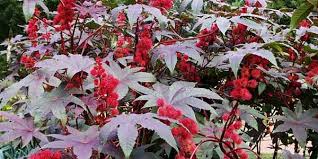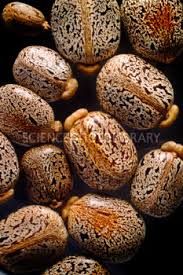http://www.sidhhaherbs.blogspot.com
Ricinus communis-ஆமணாக்குச்செடி

 The castor oil plant, Ricinus communis, is a species of
flowering plant in the spurge family, Euphorbiaceae. It belongs to a monotypic
genus, Ricinus, and subtribe, Ricininae. The evolution of castor and its
relation to other species are currently being studied using modern genetic
tools.
The castor oil plant, Ricinus communis, is a species of
flowering plant in the spurge family, Euphorbiaceae. It belongs to a monotypic
genus, Ricinus, and subtribe, Ricininae. The evolution of castor and its
relation to other species are currently being studied using modern genetic
tools.
 The plant grows throughout the tropical areas of India. In tropical regions the tree
reaches the height upto 10-12 metres, whereas, in temperate regions a slender,
woody, branching bush reaches upto 1-2 metres in height. The leaves alternate,
palmately lobed with seven serrate lobes. The flowers monoecious, male flowers
shortly stalked and female ones, sessile. The fruits are blunt, greenish,
tricoccus capsules. The seeds are ovoid, flattened, shining and pinkish-grey in
colour.
The plant grows throughout the tropical areas of India. In tropical regions the tree
reaches the height upto 10-12 metres, whereas, in temperate regions a slender,
woody, branching bush reaches upto 1-2 metres in height. The leaves alternate,
palmately lobed with seven serrate lobes. The flowers monoecious, male flowers
shortly stalked and female ones, sessile. The fruits are blunt, greenish,
tricoccus capsules. The seeds are ovoid, flattened, shining and pinkish-grey in
colour.
Ricinus communis-ஆமணாக்குச்செடி

Its seed is the castor bean which, despite its name, is not a
true bean. Castor is indigenous to the southeastern Mediterranean Basin,
Eastern Africa, and India, but is widespread throughout tropical regions (and
widely grown in Malaysia and elsewhere as an ornamental plant).
Castor seed is the source of castor oil, which has a wide
variety of uses. The seeds contain between 40% and 60% oil that is rich in
triglycerides, mainly ricinolein. The seed contains ricin, a toxin, which is
also present in lower concentrations throughout the plant.
An unrelated plant species, Fatsia japonica, is similar in
appearance and known as the false castor oil
The leaves have Anti-vatha properties.The leaves can either
be given as decoction or surasam.
The leaves are made into small pieces,then fried in castoroil
and used for formentation in case of arthritis over the swollen and painful
areas.
The leaves are heated and applied over the breast as a
bandage to induce milk secretion in case of lactating mothers.
For painful abdomen due to constipation , amenorrhoea etc
,castor oil is gently applied externally over lower abdomen.Also the heated
leaves of this plant should be externally applied over this area.
The roots are crushed and prepared as decoction and given for
3-5 days in case of pricking pain over axilla and increased vatha condition ,
lumbago,diseases of abdomen,pain around urinary bladder,
The oil prepared from seeds is castor oil.This oil is used to
induce purgation in case of constipation,intesinal worms in children,eczema and
dermatosis.
The dried seed powder is given in dose of about 1 to 2 gm in
rheumatism, lumbago, piles, constipation, diseases of liver, spleen and
sciatica etc.
For increased iyam or kapha conditions,cough,bronchial asthma
etc, 2 parts of castor oil and 1 part of honey is mixed well and given
internally to induce purgation and produce relief.
Though The Us National National University has time to search
about this medicinal plant. The Indian Siddha Medicine Has gone far away in
using as Traditional Medicine
The ancient and modern medicinal uses of the castor bean
plant, Ricinus communis L. (Euphorbiaceae), in about fifty countries worldwide,
has been surveyed. The different medicinal uses are grouped separately in
relation to their pharmacological action, whether real or presumed, within the
various medical specialties. The results show an extensive use of this plant
throughout the world and the authors suggest that further research should be
carried out to determine the active principles present in the various parts of
the plant.
The plant is classified into two types viz. white and red.
The white variety is commonly used in medicine. The botanical name of Castor Oil Plant is
Ricinus communis and it belongs to family Euphorbiaceae. The seeds contain 45%
of fixed oil, which consists glycerides of ricinoleic, isoricinoleic, stearic
and dihydroxystearic acids. The seeds have lipases and a crystalline alkaloid,
ricinine. The leaves and the stem also contain ricinine. Detection of palmitic
(1.2), stearic (0.7), arachidic (0.3), hexadecenoic (0.2), oleic (3.2),
linoleic (3.4), linolenic (0.2), ricinoleic (89.4%) and dihydroxy stearic acids as esters in castor oil by GLC
as esters in castor oil by GLC.
physicianpackiam
(49)
Comments